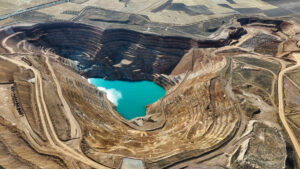Lefroy unveils new gold-copper-cobalt zone within its deepest Burns hole

Picture: Getty Images
Lefroy’s deepest hole to date at the Burns discovery in WA’s Eastern Goldfields has discovered a new zone of gold-copper-cobalt mineralisation.
The results come from a 61m interval that includes mineralised and altered diorite porphyry from a depth of 400m that returned results which correspond to stronger zones of visually identified magnetite and sulphide mineralisation.
This features a top intercept of 19.6m grading 0.33 grams per tonne (g/t) gold and 0.75% copper from a down-hole depth 428m that includes two intervals of 3.5m at 0.86g/t gold, 0.72% copper and 0.09% cobalt from 430m and 6.3m at 0.47g/t gold, 1.7% copper and 223 parts per million cobalt from 433.5m.
Importantly for Lefroy Exploration (ASX:LEX), the discovery of gold-copper-cobalt mineralisation associated with strong magnetite veining is an important new development for the strongly magnetite-altered Burns system and provides further support for the presence of a polymetallic intrusion related system.
Remaining assays from the hole LEFD006, which was co-funded by the Western Australian government under its Exploration Incentive Scheme and drilled to a total depth of 1,245m, are expected later this month.
Additionally, the initial elevated cobalt results have prompted the company to select magnetite-altered intervals from previous drillholes at Burns for cobalt analysis.
Deep diamond drilling
The four-hole deep diamond drill program at the Eastern Lefroy project was carried out to advance the company’s understanding of the scale and genesis of the intrusion-related system at Burns, which is considered to be a new and unique style of gold-copper mineralisation in the Eastern Goldfields.
While the program originally consisted of just two holes – LEFD006 and LEFD007 – a further two holes were drilled to test the priority Lovejoy prospect about 1.5km to the north of Burns.
Of the latter holes, LEFD008 intersected a thick, 145m interval of copper mineralisation from a down-hole depth of 130m.
Lovejoy is considered to be part of the larger Burns intrusive complex (BIC).
This article was developed in collaboration with Lefroy Exploration, a Stockhead advertiser at the time of publishing.
This article does not constitute financial product advice. You should consider obtaining independent advice before making any financial decisions.
Related Topics

SUBSCRIBE
Get the latest breaking news and stocks straight to your inbox.
It's free. Unsubscribe whenever you want.
By proceeding, you confirm you understand that we handle personal information in accordance with our Privacy Policy.








